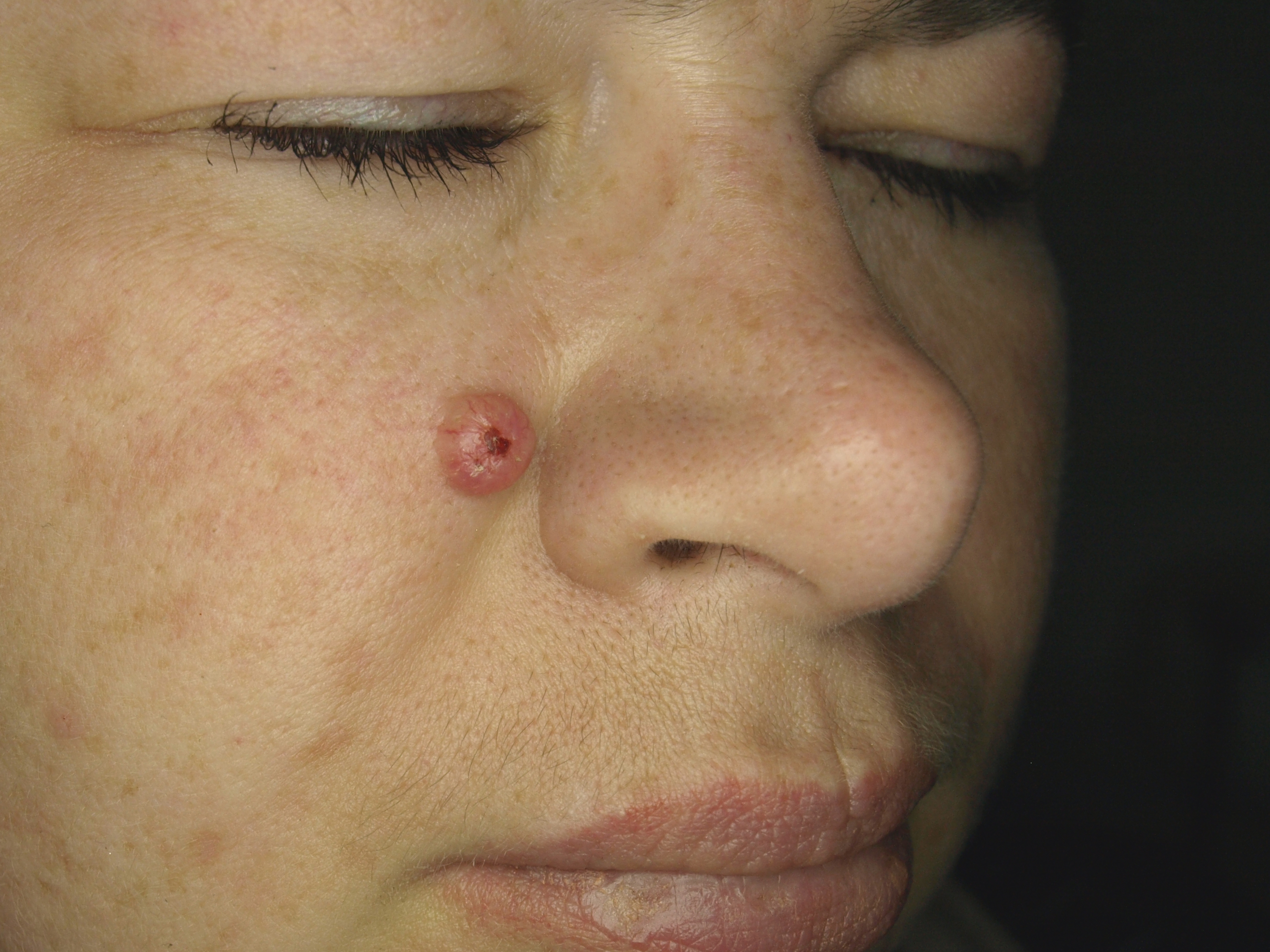Generalized trichoepithelioma
Editor-In-Chief: Prab R Tumpati, MD
Obesity, Sleep & Internal medicine
Founder, WikiMD Wellnesspedia &
W8MD medical weight loss NYC and sleep center NYC
| Generalized trichoepithelioma | |
|---|---|

| |
| Synonyms | Multiple familial trichoepithelioma |
| Pronounce | N/A |
| Specialty | Dermatology |
| Symptoms | Multiple small skin-colored papules |
| Complications | Basal cell carcinoma |
| Onset | Childhood or adolescence |
| Duration | Lifelong |
| Types | N/A |
| Causes | Genetic mutation |
| Risks | Family history |
| Diagnosis | Skin biopsy, Genetic testing |
| Differential diagnosis | Basal cell carcinoma, Syringoma, Milia |
| Prevention | N/A |
| Treatment | Surgical excision, Laser therapy, Electrodesiccation |
| Medication | Topical retinoids, Oral retinoids |
| Prognosis | Generally benign |
| Frequency | Rare |
| Deaths | N/A |
Generalized trichoepithelioma is a rare genetic disorder characterized by the presence of multiple benign skin tumors known as trichoepitheliomas. These tumors originate from the hair follicles and are typically found on the face, scalp, and neck.
Clinical Features[edit | edit source]
Generalized trichoepithelioma presents with numerous small, firm, skin-colored papules. These papules are usually symmetrically distributed and can coalesce into larger plaques. The condition is often first noticed in childhood or adolescence and tends to progress with age.
Symptoms[edit | edit source]
- Multiple papules on the face, particularly around the nose, cheeks, and forehead. - Papules may also appear on the scalp, neck, and upper trunk. - Lesions are typically asymptomatic but can occasionally cause itching or irritation.
Pathophysiology[edit | edit source]
Generalized trichoepithelioma is caused by mutations in the CYLD gene, which is responsible for encoding a protein that regulates cell growth and division. The mutation leads to uncontrolled proliferation of cells in the hair follicle, resulting in tumor formation.
Diagnosis[edit | edit source]
Diagnosis is primarily clinical, based on the characteristic appearance of the lesions. A skin biopsy can be performed to confirm the diagnosis, revealing nests of basaloid cells with peripheral palisading and keratin cysts.
Treatment[edit | edit source]
There is no definitive cure for generalized trichoepithelioma, but several treatment options can help manage the condition: - Surgical excision: Individual lesions can be removed surgically, although new lesions may develop. - Laser therapy: Carbon dioxide laser or pulsed dye laser can be used to reduce the appearance of lesions. - Topical treatments: Topical retinoids or imiquimod cream may be used to reduce lesion size.
Prognosis[edit | edit source]
The prognosis for individuals with generalized trichoepithelioma is generally good, as the condition is benign and does not affect overall health. However, the cosmetic appearance of the lesions can be distressing for patients.
See Also[edit | edit source]
- Trichoepithelioma - Basal cell carcinoma - Skin tumor - Genetic disorder
Search WikiMD
Ad.Tired of being Overweight? Try W8MD's physician weight loss program.
Semaglutide (Ozempic / Wegovy and Tirzepatide (Mounjaro / Zepbound) available.
Advertise on WikiMD
|
WikiMD's Wellness Encyclopedia |
| Let Food Be Thy Medicine Medicine Thy Food - Hippocrates |
Translate this page: - East Asian
中文,
日本,
한국어,
South Asian
हिन्दी,
தமிழ்,
తెలుగు,
Urdu,
ಕನ್ನಡ,
Southeast Asian
Indonesian,
Vietnamese,
Thai,
မြန်မာဘာသာ,
বাংলা
European
español,
Deutsch,
français,
Greek,
português do Brasil,
polski,
română,
русский,
Nederlands,
norsk,
svenska,
suomi,
Italian
Middle Eastern & African
عربى,
Turkish,
Persian,
Hebrew,
Afrikaans,
isiZulu,
Kiswahili,
Other
Bulgarian,
Hungarian,
Czech,
Swedish,
മലയാളം,
मराठी,
ਪੰਜਾਬੀ,
ગુજરાતી,
Portuguese,
Ukrainian
Medical Disclaimer: WikiMD is not a substitute for professional medical advice. The information on WikiMD is provided as an information resource only, may be incorrect, outdated or misleading, and is not to be used or relied on for any diagnostic or treatment purposes. Please consult your health care provider before making any healthcare decisions or for guidance about a specific medical condition. WikiMD expressly disclaims responsibility, and shall have no liability, for any damages, loss, injury, or liability whatsoever suffered as a result of your reliance on the information contained in this site. By visiting this site you agree to the foregoing terms and conditions, which may from time to time be changed or supplemented by WikiMD. If you do not agree to the foregoing terms and conditions, you should not enter or use this site. See full disclaimer.
Credits:Most images are courtesy of Wikimedia commons, and templates, categories Wikipedia, licensed under CC BY SA or similar.
Contributors: Prab R. Tumpati, MD

